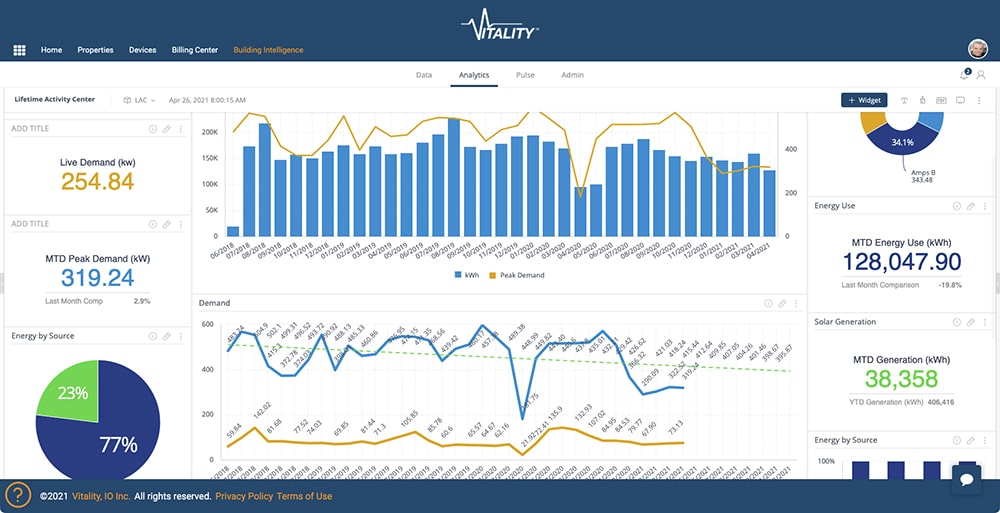Building automation (BAS) automates the controls of a building, programs a building to start-up, heat, or cool to a particular temperature, and shut down, all in one place. A BAS is fundamentally designed to control the systems of a building. It doesn’t indicate how efficiently these systems run and how and where electric, water, and gas resources are consumed.
Vitality (EMS) provides detailed transparency into utility resource consumption as well as provides tools to run a building more efficiently. Facility managers often say they have EMS when, in reality, they have a BAS. Below are listed key differences between the two systems and how Vitality can enhance the performance of a BAS.
Actionable Energy Consumption Analysis
A BAS, if programmed properly, is great at controlling energy use and addressing building occupant comfort issues but does not provide insight into the resultant consumption and building operations. With Vitality (EMS) facility managers can see what their buildings are consuming and use this information to better program their BAS for efficiency, comfort, and space utilization.
Granular Energy Use Data
Using Vitality (EMS) a facility manager can see a building’s electric, water, and gas consumption at the whole building, sub-metered space, and equipment level. A BAS focuses on the processes, not consumption, so it does not provide any utility use insights.
Data-Driven Smart Decisions
Vitality (EMS) provides visual tools and reports to make data actionable e.g. it provides near real-time granular data that can identify areas of inefficiency and high consumption, allowing users to target operational improvement efforts.
Portfolio Data Centralized in The Cloud
Vitality (EMS) naturally centralizes all water, electric, and gas data in a cloud platform. Facility managers can then access this data from anywhere to gain insights into their entire portfolio’s energy consumption. BAS systems are specialized for one particular building and are not fundamentally designed to provide portfolio-level transparency or benchmarking.
Rapid Implementation and Payback
Vitality (EMS) deploys quickly, is scalable, does not require specialized training, and can be applied across a portfolio without affecting existing BAS settings, resulting in a quick return on investment (ROI). A BAS requires customized design and set up in addition to 3rd party implementation and/or upfront specialized training to run properly, which takes time and money.
No Annual Training Required
Vitality (EMS) is a user-friendly system—actionable data in a simple, easy-to-use platform—that does not necessitate frequent training sessions that eat up valuable time. A BAS can be particularly complex, requiring time to train and retrain staff every year.
Team Collaboration
Vitality provides the luxury of unlimited users so customer teams can collaborate on an energy management system’s platform via chat or work order integrations. For example, cadence reports can help team members work together to manage energy consumption across the client’s portfolio, trending data can be used to predict costs and budgets, engineering-focused teams can more accurately predict the proper settings of a BAS.
Predictive Maintenance and more
Vitality (EMS) Stores historical data in the cloud which can be used to identify anomaly events, such as high energy consumption.
Technicians can then check equipment and systems for faults; a BAS system’s information in conjunction with the Vitality data could be used to help in this process.
Validate Measurement and Verification
Vitality M&V 2.0 can serve as an auditing system for a BAS, for Energy Conservation Measures (ECMs), and Energy Efficiency Building Retrofits.
Integrate With Building Management Tools
Vitality (EMS) as a core feature can easily integrate and automate building management tools such as tenant billing and benchmarking or reporting systems like Energy Star Portfolio Manager. A BAS system is not designed to do this.





